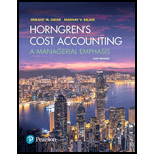
REVEL for Horngren's Cost Accounting: A Managerial Emphasis -- Access Card (16th Edition) (What's New in Accounting)
16th Edition
ISBN: 9780134789705
Author: Srikant M. Datar, Madhav V. Rajan
Publisher: PEARSON
expand_more
expand_more
format_list_bulleted
Textbook Question
Chapter 20, Problem 20.16MCQ
The order size associated with the economic-order-quantity (EOQ) model will necessarily decline if:
- a. Ordering costs rise
- b. Storage costs rise
- c. Insurance costs for materials in storage fall
- d. Stockout costs rise
Expert Solution & Answer
Want to see the full answer?
Check out a sample textbook solution
Students have asked these similar questions
Provide correct answer is accounting
Milani, Incorporated, acquired 10 percent of Seida Corporation on January 1, 2023, for $190,000 and appropriately accounted for the
investment using the fair-value method. On January 1, 2024, Milani purchased an additional 30 percent of Seida for $600,000 which
resulted in significant influence over Seida. On that date, the fair value of Seida's common stock was $2,000,000 in total. Seida's
January 1, 2024, book value equaled $1,850,000, although land was undervalued by $120,000. Any additional excess fair value over
Seida's book value was attributable to a trademark with an eight-year remaining life. During 2024, Seida reported income of $300,000
and declared and paid dividends of $110,000.
Required:
Prepare the 2024 journal entries for Milani related to its investment in Seida.
Note: If no entry is required for a transaction/event, select "No journal entry required" in the first account field.
View transaction list
Journal entry worksheet
The leo company had
Chapter 20 Solutions
REVEL for Horngren's Cost Accounting: A Managerial Emphasis -- Access Card (16th Edition) (What's New in Accounting)
Ch. 20 - Why do better decisions regarding the purchasing...Ch. 20 - Name six cost categories that are important in...Ch. 20 - What assumptions are made when using the simplest...Ch. 20 - Give examples of costs included in annual carrying...Ch. 20 - Give three examples of opportunity costs that...Ch. 20 - What are the steps in computing the cost of a...Ch. 20 - Why might goal-congruence issues arise when...Ch. 20 - JIT purchasing has many benefits but also some...Ch. 20 - What are three factors causing reductions in the...Ch. 20 - You should always choose the supplier who offers...
Ch. 20 - Prob. 20.11QCh. 20 - What are the main features of JIT production, and...Ch. 20 - Distinguish inventory-costing systems using...Ch. 20 - Describe three different versions of backflush...Ch. 20 - Discuss the differences between lean accounting...Ch. 20 - The order size associated with the...Ch. 20 - Prob. 20.17MCQCh. 20 - Prob. 20.18MCQCh. 20 - Lyle Co. has only one product line. For that line,...Ch. 20 - Just-in-time inventory assumes all of the...Ch. 20 - Economic order quantity for retailer. Wonder Line...Ch. 20 - Economic order quantity, effect of parameter...Ch. 20 - EOQ for a retailer. The Fabric World sells fabrics...Ch. 20 - EOQ for manufacturer. Sk8 Company produces...Ch. 20 - Sensitivity of EOQ to changes in relevant ordering...Ch. 20 - JIT production, relevant benefits, relevant costs....Ch. 20 - Backflush costing and JIT production. Grand...Ch. 20 - Backflush costing, two trigger points, materials...Ch. 20 - Backflush costing, two trigger points, completion...Ch. 20 - Prob. 20.30PCh. 20 - Prob. 20.31PCh. 20 - Prob. 20.32PCh. 20 - Prob. 20.33PCh. 20 - JIT purchasing, relevant benefits, relevant costs....Ch. 20 - Supply-chain effects on total relevant inventory...Ch. 20 - Supply-chain effects on total relevant inventory...Ch. 20 - Backflush costing and JIT production. The Acton...Ch. 20 - Backflush, two trigger points, materials purchase...Ch. 20 - Backflush, two trigger points, completion of...Ch. 20 - Lean accounting. Reliable Security Devices (RSD)...Ch. 20 - JIT production, relevant benefits, relevant costs,...
Knowledge Booster
Learn more about
Need a deep-dive on the concept behind this application? Look no further. Learn more about this topic, accounting and related others by exploring similar questions and additional content below.Similar questions
arrow_back_ios
SEE MORE QUESTIONS
arrow_forward_ios
Recommended textbooks for you
 Managerial Accounting: The Cornerstone of Busines...AccountingISBN:9781337115773Author:Maryanne M. Mowen, Don R. Hansen, Dan L. HeitgerPublisher:Cengage Learning
Managerial Accounting: The Cornerstone of Busines...AccountingISBN:9781337115773Author:Maryanne M. Mowen, Don R. Hansen, Dan L. HeitgerPublisher:Cengage Learning


Managerial Accounting: The Cornerstone of Busines...
Accounting
ISBN:9781337115773
Author:Maryanne M. Mowen, Don R. Hansen, Dan L. Heitger
Publisher:Cengage Learning
Inventory management; Author: The Finance Storyteller;https://www.youtube.com/watch?v=DZhHSR4_9B4;License: Standard Youtube License